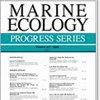根据密西西比湾西部的食物数量和质量指标,对东部牡蛎幼虫的表现进行模型估算
IF 2.1
3区 环境科学与生态学
Q2 ECOLOGY
引用次数: 0
摘要
摘要:在美国密西西比海湾等退化的河口系统中,牡蛎(Crassostrea virginica)种群的恢复至关重要。由于最近的多次死亡事件,密西西比海湾西部的牡蛎种群受到了繁殖限制;种群增长受到新个体进入现存种群的限制。因此,牡蛎的恢复需要充足的幼体供应,使其能够及时发育、生长并成功变态。幼体的表现和定居潜力受环境温度、盐度和食物供应的影响。食物的数量对幼虫很重要,但食物的质量也很重要,因为幼虫需要均衡的脂质、蛋白质和碳水化合物,才能在变态过程中发育和存活。在这项研究中,将密西西比湾西部 7 个牡蛎礁 2021 年和 2022 年产卵季节的原地环境和食物条件整合到一个基于生化的幼虫表现模型中,以估计有利于成功变态的时期。在 2021 年,由于盐度长期极低(5 ppt)和食物供应不均衡,模型估计的幼体存活率在产卵季节的大部分时间都受到抑制。尽管食物总含量较低,但较高的季节盐度和更均衡的食物组成提高了模型估计的 2022 年幼虫存活率,这表明幼虫的表现主要受可用食物质量的影响。将模型估算的沉降窗口与同时进行的野外观察得出的沉降窗口进行了比较。模型估计的沉降窗口与观测到的沉降窗口之间的高度一致验证了该模型的有效性,并揭示了密西西比湾西部招募限制的根本原因。本文章由计算机程序翻译,如有差异,请以英文原文为准。
Model estimation of eastern oyster larval performance from food quantity and quality measures in western Mississippi Sound
ABSTRACT: Oyster Crassostrea virginica population recovery is critical in degraded estuarine systems, such as Mississippi Sound, USA, where repeated mass mortality events have depleted local oyster stocks. Owing to multiple recent die-offs, the western Mississippi Sound oyster population is recruitment-limited; population growth is constrained by the entry of new individuals into the extant population. Therefore, oyster recovery requires an adequate supply of larvae capable of timely development, growth, and successful metamorphosis. Larval performance and settlement potential are influenced by ambient temperature, salinity, and food supply. Food quantity is important to larvae, but so is food quality, as larvae require a balanced diet of lipids, proteins, and carbohydrates to develop and survive through metamorphosis. In this study, in situ environmental and food conditions during the 2021 and 2022 spawning seasons from 7 oyster reefs in western Mississippi Sound were integrated into an established biochemically based larval performance model to estimate periods facilitative of successful metamorphosis. In 2021, model-estimated larval survivorship was suppressed through much of the spawning season by prolonged, extremely low salinity (<5 ppt) and inadequately balanced food supply. Higher seasonal salinity and more balanced food composition increased model-estimated larval survivorship in 2022, despite lower total food content, suggesting larval performance was primarily governed by the quality of available food. Model-estimated settlement windows were compared to settlement windows derived from concomitant field observations of recruitment. Strong agreement between model-estimated and observed settlement windows validates the effectiveness of the model and informs on the underlying causes of recruitment limitation in western Mississippi Sound.
求助全文
通过发布文献求助,成功后即可免费获取论文全文。
去求助
来源期刊

Marine Ecology Progress Series
环境科学-海洋学
CiteScore
5.30
自引率
8.00%
发文量
238
审稿时长
3 months
期刊介绍:
The leading journal in its field, MEPS covers all aspects of marine ecology, fundamental and applied. Topics covered include microbiology, botany, zoology, ecosystem research, biological oceanography, ecological aspects of fisheries and aquaculture, pollution, environmental protection, conservation, and resource management.
 求助内容:
求助内容: 应助结果提醒方式:
应助结果提醒方式:


